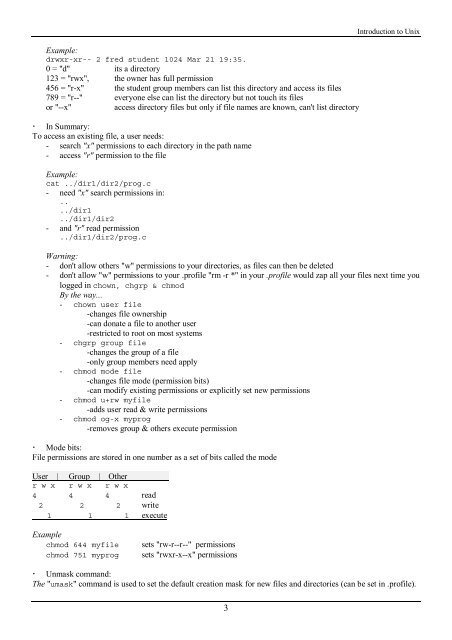You also want an ePaper? Increase the reach of your titles
YUMPU automatically turns print PDFs into web optimized ePapers that Google loves.
Example:<br />
drwxr-xr-- 2 fred student 1024 Mar 21 19:35.<br />
0 = "d" its a directory<br />
123 = "rwx", <strong>the</strong> owner has full permission<br />
456 = "r-x" <strong>the</strong> student group members can list this directory and access its files<br />
789 = "r--" everyone else can list <strong>the</strong> directory but not touch its files<br />
or "--x"<br />
access directory files but only if file names are known, can't list directory<br />
! In Summary:<br />
To access an existing file, a user needs:<br />
- search "x" permissions to each directory in <strong>the</strong> path name<br />
- access "r" permission to <strong>the</strong> file<br />
Example:<br />
cat ../dir1/dir2/prog.c<br />
- need "x" search permissions in:<br />
..<br />
../dir1<br />
../dir1/dir2<br />
- and "r" read permission<br />
../dir1/dir2/prog.c<br />
Introduction to <strong>Unix</strong><br />
Warning:<br />
- don't allow o<strong>the</strong>rs "w" permissions to your directories, as files can <strong>the</strong>n be deleted<br />
- don't allow "w" permissions to your .profile "rm -r *" in your .profile would zap all your files next time you<br />
logged in chown, chgrp & chmod<br />
By <strong>the</strong> way...<br />
- chown user file<br />
-changes file ownership<br />
-can donate a file to ano<strong>the</strong>r user<br />
-restricted to root on most systems<br />
- chgrp group file<br />
-changes <strong>the</strong> group of a file<br />
-only group members need apply<br />
- chmod mode file<br />
-changes file mode (permission bits)<br />
-can modify existing permissions or explicitly set new permissions<br />
- chmod u+rw myfile<br />
-adds user read & write permissions<br />
- chmod og-x myprog<br />
-removes group & o<strong>the</strong>rs execute permission<br />
! Mode bits:<br />
File permissions are stored in one number as a set of bits called <strong>the</strong> mode<br />
User | Group | O<strong>the</strong>r<br />
r w x r w x r w x<br />
4 4 4 read<br />
2 2 2 write<br />
1 1 1 execute<br />
Example<br />
chmod 644 myfile<br />
chmod 751 myprog<br />
sets "rw-r--r--" permissions<br />
sets "rwxr-x--x" permissions<br />
! Unmask command:<br />
The "umask" command is used to set <strong>the</strong> default creation mask for new files and directories (can be set in .profile).<br />
3
















